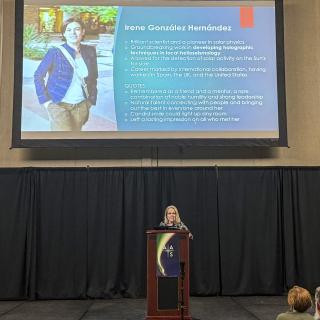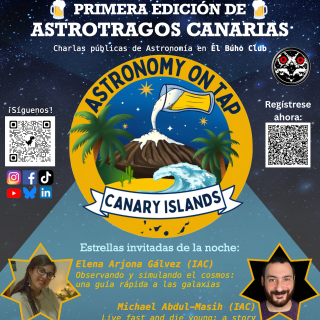It may interest you
-
 The award, instituted in honour of Canary Island scientist Irene González Hernández, recognises excellence in solar research and scientific leadership. The Instituto de Astrofísica de Canarias (IAC) celebrates the awarding of the inaugural Irene González Hernández prize to Dr. Holly R. Gilbert, director of the High Altitude Observatory (HAO) of the National Center for Atmospheric Research (NCAR) of the US National Science Foundation. The award was presented at the 56th meeting of the Solar Physics Division (SPD) of the American Astronomical Society (AAS), held jointly with the AAS and theAdvertised on
The award, instituted in honour of Canary Island scientist Irene González Hernández, recognises excellence in solar research and scientific leadership. The Instituto de Astrofísica de Canarias (IAC) celebrates the awarding of the inaugural Irene González Hernández prize to Dr. Holly R. Gilbert, director of the High Altitude Observatory (HAO) of the National Center for Atmospheric Research (NCAR) of the US National Science Foundation. The award was presented at the 56th meeting of the Solar Physics Division (SPD) of the American Astronomical Society (AAS), held jointly with the AAS and theAdvertised on -
 The Instituto de Astrofísica de Canarias (IAC) announces the arrival of the Astronomy on Tapinternational talk series in Spain, with its very first edition to be held in Tenerife. This outreach initiative, which was created in the United States and has since expanded worldwide, will now take place in the Canary Islands under the name "Astronomy on Tap – Canary Islands” and the local nickname “AstroTragos,” and is carried out within the framework of the EDUCADO and ExGal-Twin projects at IAC. The debut event will be held at the Búho Club (Calle Catedral, 3, La Laguna, Tenerife) on ThursdayAdvertised on
The Instituto de Astrofísica de Canarias (IAC) announces the arrival of the Astronomy on Tapinternational talk series in Spain, with its very first edition to be held in Tenerife. This outreach initiative, which was created in the United States and has since expanded worldwide, will now take place in the Canary Islands under the name "Astronomy on Tap – Canary Islands” and the local nickname “AstroTragos,” and is carried out within the framework of the EDUCADO and ExGal-Twin projects at IAC. The debut event will be held at the Búho Club (Calle Catedral, 3, La Laguna, Tenerife) on ThursdayAdvertised on -
 The Instituto de Astrofísica de Canarias (IAC) has initiated a project of science outreach in the Tenerife-II prison in El Rosario, with the aim of bringing knowledge about the Universe to the prisoners, as well as to the educational and other working personnel at that centre. This initiative is taken in the framework of the commitment of the IAC to the popularization of science as a tool for inclusión and social transformation. The project is led by the astrophysicist, and IAC researcher David Aguado and is a continuation of a first experiment in 2024 in the Madrid V prison at Soto del RealAdvertised on
The Instituto de Astrofísica de Canarias (IAC) has initiated a project of science outreach in the Tenerife-II prison in El Rosario, with the aim of bringing knowledge about the Universe to the prisoners, as well as to the educational and other working personnel at that centre. This initiative is taken in the framework of the commitment of the IAC to the popularization of science as a tool for inclusión and social transformation. The project is led by the astrophysicist, and IAC researcher David Aguado and is a continuation of a first experiment in 2024 in the Madrid V prison at Soto del RealAdvertised on
